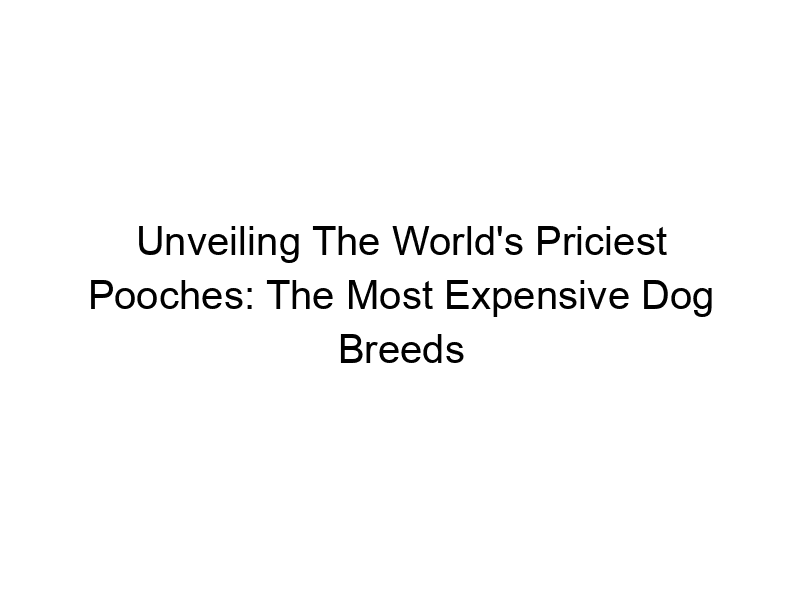Owning a dog is a rewarding experience, offering companionship, loyalty, and unconditional love. But for some, the desire for a prestigious canine companion translates into a significant financial investment. This exploration delves into the most expensive dog breeds in the world, uncovering the factors that contribute to their exorbitant price tags and providing insights into their unique characteristics. We’ll examine various breeds, their history, and what makes them so desirable—and costly. You’ll learn about their distinctive traits, health concerns, grooming needs, and the overall commitment required to own these exceptional animals.
The most significant factor driving up the price of certain dog breeds is their rarity. Limited breeding programs, stringent breed standards, and low reproduction rates all contribute to a limited supply. This scarcity naturally inflates the demand, leading to higher
prices. Think of it like a limited-edition collectible item; the fewer available, the more valuable they become.
The Role of Breed Standards and Lineage
Pedigree and Champion Bloodlines
The lineage of a dog plays a crucial role in its price. Dogs with pedigrees tracing back to champion bloodlines, those that have won prestigious dog shows and competitions, command significantly higher prices. Buyers are often willing to pay a premium for dogs with proven genetic traits and a history of excellence within their breed.
Breed-Specific Health Concerns and Veterinary Care
Genetic Predispositions and Specialized Care
Certain breeds are prone to specific health issues, requiring specialized veterinary care and ongoing medical expenses. These costs can be substantial, contributing to the overall cost of ownership. For example, some breeds might be predisposed to hip dysplasia, requiring expensive treatments or surgeries throughout their lives.
Training and Socialization Costs
Professional Training and Handling
Some of the most expensive dog breeds require specialized training and socialization from an early age. This can involve the services of professional dog trainers, adding to the overall cost of ownership. These breeds may have unique temperaments or behavioral traits that necessitate professional guidance to ensure they are well-adjusted and well-behaved companions.
Grooming and Maintenance Expenses
Specialized Grooming Needs and Supplies
Many high-priced breeds require regular and specialized grooming. This includes professional grooming appointments, specialized shampoos and conditioners, and possibly regular trimming or other treatments. The costs associated with maintaining their unique coats can quickly accumulate.
The Impact of Breeder Reputation and Ethics
Ethical Breeding Practices and Reputable Breeders
Reputable breeders who prioritize the health and well-being of their dogs often charge higher prices. They invest in thorough health testing, carefully select breeding pairs, and provide extensive socialization and care for their puppies. This commitment to ethical breeding practices translates to healthier, better-adjusted dogs, but it also increases the cost of acquiring one.
Examples of Some of the Most Expensive Dog Breeds
Tibetan Mastiff
Known for their imposing size and distinctive appearance, Tibetan Mastiffs have commanded extremely high prices, with some fetching hundreds of thousands of dollars. Their rarity, ancient lineage, and powerful presence all contribute to their value.
Samoyed
With their striking white coats and friendly demeanor, Samoyeds are highly sought after. Their luxurious coats require regular grooming and maintenance, adding to the overall cost of ownership.
Lowchen
This small, elegant breed, also known as the Little Lion Dog, is prized for its playful personality and unique appearance. Their relatively small size doesn’t necessarily translate to a low price tag, due to factors like breeding rarity.
Afghan Hound
Famous for their flowing coats and graceful movements, Afghan Hounds require significant grooming and specialized care. Their elegant appearance and historical significance contribute to their high value.
French Bulldog
While not always at the top of the most expensive list, French Bulldogs have risen in popularity, driving up their prices. Their compact size and charming personality make them highly desirable companions, but their popularity can also mean higher costs from ethical breeders.
Factors Influencing the Price Beyond Breed
Location and Demand
The geographical location can significantly impact the price of a dog. In areas with high demand and a limited supply of a particular breed, prices tend to be higher. Regional variations in breeding practices and market conditions can also play a role.
The Importance of Research Before Purchasing
Finding Reputable Breeders and Avoiding Puppy Mills
Choosing a reputable breeder is crucial when purchasing an expensive dog breed. It’s important to research potential breeders thoroughly, ensuring they prioritize the health and well-being of their animals. Avoid puppy mills, which often prioritize profit over animal welfare, resulting in unhealthy and poorly socialized puppies.
Understanding the Total Cost of Ownership
Budgeting for Ongoing Expenses
Purchasing a puppy is just the beginning. It’s essential to create a realistic budget to cover ongoing expenses, including food, veterinary care, grooming, training, and other essentials. Expensive breeds often require more specialized care, leading to higher ongoing costs.
Comparing Costs Across Different Breeds
Price Variations Within and Between Breeds
Prices for even the same breed can vary substantially depending on lineage, pedigree, breeder reputation, and other factors. It’s crucial to compare prices from multiple reputable sources and understand the factors influencing the variation before making a purchasing decision.
Making an Informed Decision
Weighing the Costs and Benefits
Ultimately, the decision to purchase an expensive dog breed should be well-considered. It’s crucial to carefully weigh the potential costs against the benefits, ensuring you are prepared to provide the necessary care and commitment for the animal’s entire life.
Frequently Asked Questions
What are the common health issues of expensive dog breeds?
Expensive dog breeds, due to selective breeding, can sometimes be prone to specific health problems. These can include hip and elbow dysplasia (common in larger breeds), eye problems (various breeds), heart conditions (various breeds), and certain types of cancer. The specific health concerns vary greatly depending on the breed.
How much does it typically cost to insure an expensive dog breed?
Pet insurance costs vary depending on factors like the dog’s breed, age, location, and the level of coverage. Expensive breeds might have higher insurance premiums due to their predisposition to certain health issues. Expect to pay a higher monthly premium than for more common breeds. Research different pet insurance providers to compare costs and coverage.
Are expensive dog breeds necessarily better?
Not necessarily. While expensive breeds may have desirable traits like specific looks or temperaments, it’s not a guarantee of a better companion. Many well-adjusted and loving dogs are found in shelters or are available from responsible breeders of less-expensive breeds. Ethical breeding practices and proper socialization are what truly contribute to a well-behaved and healthy pet, regardless of price.
What is the average lifespan of these breeds?
The average lifespan varies dramatically depending on breed and health factors. Some larger breeds may only live for 8-10 years, while smaller breeds could live to 12-15 years or more. Careful breeding and good health care can influence lifespan, but each individual dog’s health trajectory is unique.
How can I find a reputable breeder for an expensive dog?
Thorough research is crucial. Look for breeders who are transparent about their breeding practices, health testing of their dogs, and the puppies’ socialization. Ask to see the parents and the puppy’s living environment. Reputable breeders won’t hesitate to provide references and answer your questions.
Final Thoughts
Owning one of the most expensive dog breeds in the world is a significant commitment, involving not only a substantial upfront investment but also substantial ongoing expenses related to specialized care, grooming, and potential health issues. Before making such a decision, thorough research is essential to understand the complexities involved. However, for those prepared to make this significant commitment, owning these magnificent animals can be an extraordinarily rewarding experience. The joy, companionship, and unique bond formed with one of these exceptional dogs can be priceless. Remember to always prioritize responsible pet ownership and consider adopting a dog from a shelter or rescue organization—you may discover your perfect match without the high price tag.




